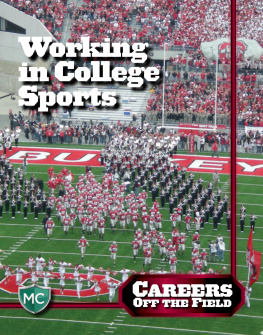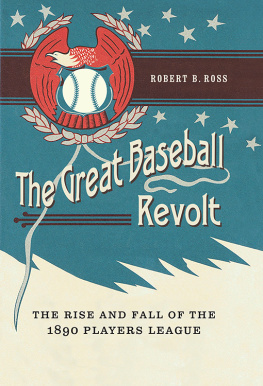
An imprint of Penguin Random House LLC
375 Hudson Street
New York, New York 10014

Copyright 2018 by Zachary Schonbrun
Penguin supports copyright. Copyright fuels creativity, encourages diverse voices, promotes free speech, and creates a vibrant culture. Thank you for buying an authorized edition of this book and for complying with copyright laws by not reproducing, scanning, or distributing any part of it in any form without permission. You are supporting writers and allowing Penguin to continue to publish books for every reader.
DUTTON and the D colophon are registered trademarks of Penguin Random House LLC.
LIBRARY OF CONGRESS CATALOGING-IN-PUBLICATION DATA
Names: Schonbrun, Zach, author.
Title: The performance cortex : how neuroscience is redefining athletic genius / Zach Schonbrun.
Description: New York, New York : Dutton, [2018] | Includes bibliographical references and index.
Identifiers: LCCN 2017048817 (print) | LCCN 2017050826 (ebook) | ISBN 9781101986349 (ebook) | ISBN 9781101986332 (hc)
Subjects: LCSH: SportsPhysiological aspects. | AthletesPhysiology. | Neurophysiology. | Cerebral cortexPhysiology. | BISAC: SPORTS & RECREATION / Sports Psychology. | SCIENCE / Life Sciences / Neuroscience. | SPORTS & RECREATION / Training.
Classification: LCC RC1236.N47 (ebook) | LCC RC1236.N47 S36 2018 (print) | DDC 612/.044dc23
LC record available at https://lccn.loc.gov/2017048817
Design and illustrations by Daniel Lagin
While the author has made every effort to provide accurate telephone numbers, Internet addresses, and other contact information at the time of publication, neither the publisher nor the author assumes any responsibility for errors or for changes that occur after publication. Further, the publisher does not have any control over and does not assume any responsibility for author or third-party websites or their content.
Version_1
To my parents.
And to Missy, my reason for movement.
INTRODUCTION
Last spring, I traveled to Dublin to attend the Society for the Neural Control of Movements annual conference, where I heard, on day one, a presenter elegize the recent passing of a dear colleague. He was never happier than when he was descending electrodes into the spinal cord looking for a neuron, he said. When he found one, he treated it like the first neuron he found. A lesson therein for us all. I myself was not sure what exactly I had descended into. One attendee, Elbieta Jankowska, began her career stimulating the lumbosacral region of decerebrate cats more than half a century ago. Another claimed to be the academic great-great-grandson of Claude Bernard. One of the most decorated active researchers in the world, Tom Jessell, was there to discuss his work with mouse genetic tools. And me? I was there because of my wife.
She discovered the small blurb in my Columbia University alumni magazine about the two neuroscientists trying to work in Major League Baseball. I knew of sports psychology, mindfulness training, even brain gaming as a growing fad among professional franchises. But neuroscience seemed to represent a different level of sobriety. What were they looking for? What had they found?
I met Jason Sherwin at a dingy Jamaican buffet with a bright crimson awning in East Flatbush, across from the SUNY Downstate hospital where he was working. We still joke about the mystery meat served alongside collard greens and gummy plantains. We spoke for two hours as he related his life, his rsum, how he met Jordan Muraskin, how he envisioned their company as helping to usher in Moneyball 2.0: biometric analytics, a priori probabilities, brain data. I wrote the story for the website SB Nation Longform, a now-defunct outlet for sportswritings deep cuts. But as I wrote it, I knew it was a sports article by its place of residence only. On the surface, the efforts by Jason and Jordan were intended to help professional baseball teams scout and improve hitters. But, to zoom out a bit, their endeavor seemed to be more like tracing the essential correlates of a skill. This skill could be anything that requires a rapid decision: passing to an open wide receiver, whistling a foul call, responding to gunfire after a report of breaking and entering. Those are outcomes, like the speed of a car as it zips down the highway. Jason and Jordan encouraged me to reconsider what is going on beneath the hood. Hitting a baseball, to take one of the more straightforward outcomes, has been deemed the most difficult thing to do in sport. Some might quibble about this, but those who do normally have not tried it. The most proficient hitters are hardly at all cut from the same cloth. The two front-runners for the Most Valuable Player of the American League in 2017, in fact, were a Venezuelan infielder standing five feet, six inches tall and weighing 165 pounds (Jos Altuve) and a Californian outfielder standing six feet, seven inches and weighing 282 pounds (Aaron Judge). We already know what distinguishes them; we can see it. So what relates them? What actually is responsible for their skill? Jason and Jordan wondered, and so did I, once I really started to think about it. It would seem to have nothing to do with their biceps muscles or fast-twitch fibers or even their vision, which for most baseball players is largely the same. It would seem to have much more to do with the neural signals that impel our every movement.
How do we move? A few people have looked into this. The Egyptians actually wrote of head injuries and movement disorders. Erasistratus and Herophilus explored the cerebella of fast-moving animals like deer and rabbits. Galen of Pergamon learned about the brain from tending to the wounds of the gladiators. The origin of movement had bewitched some of historys shrewdest minds: Alcmaeon, Plato, Aristotle, Posidonius, Al-Razi, Descartes, Newton, Franklin. When the brains primary seat of voluntary action, the motor cortex, was finally discovered, by a pair of wayward Germans in 1870, the operation had been conducted on a dog sprawled across a dresser at the home of one of the men. The eureka moment howled from a living room in Berlin.
Since then, most of the motor research has been conducted more quietly. For some reason, the field does not seem to attract the attention given to clinical tales or the various meditations on our cognition, such as the neuroscience of self; the neuroscience of language; the neuroscience of dogs; the neuroscience of consciousness; the neuroscience of being a good parent. An Amazon book search on the phrase neuroscience of movement turned up a fuchsia textbook by a professor of physical therapy published in 1997 and scant other options. Part of the problem might be that the question of movement sounds old and elemental, the stuff of anatomy classes and collapsible polyvinyl skeletons. The other problem is that progress has been a bit slow. When I visited one neuroscientist, he was in the middle of crafting a rebuttal to a controversial interpretation of motor learning. The offending interpretation was made in 1951. A popular experimental paradigm in most motor research labs is called a force-field adaptation task, which was first introduced in 1994. It replaced the reciprocal protocol task, born in 1954. Other techniques came and went. Theories appeared and disappeared like pimples. As I walked outside the conference hall at the Clayton Hotel during the NCM meeting, I scanned the bewildering titles on hundreds of posters, each being presented with hand waves and speeches in fast-forward by nervous postdocs. All of this is going to change, said Jordan Taylor, a professor at Princeton, waving his own hand toward the rows. Maybe he was right. I hoped to capture it while it lasted.

















